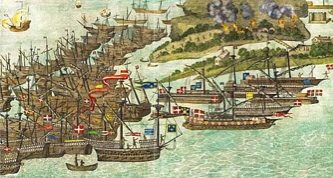Sandown at war

The French invasion started the Battle of the Solent. The Mary Rose sank on her way to the fight
The northern landing of the French invasion of 1545 took place at Whitecliff Bay, north of Culver Down. The French were attacked from the Down’s higher ground but managed to make it to Sandown where they were finally defeated. Sandown’s defences didn’t yet include Sandown fort, which was under construction at the time of the attack. Built just offshore, where Fort Street meets Culver Parade, it was not well founded and the sea had breached the curtain wall by 1623. It was demolished and a new fort built further inland.

Sandown’s Granite Fort helped the Allies at D-Day. Photo: FluteFlute
In 1859 a Royal Commission decided that it did not offer suitable protection and a new fort was built of granite. This became operational in 1876 and still stands, housing the Isle of Wight Zoo. During WWII, the fort played a significant role in the D-Day landings as it housed 16 of the pumps that powered the PLUTO (Pipe Line Under The Ocean) that kept the Allies supplied with fuel. Each pumped 36,000 gallons of fuel per day at a pressure of 1,500lb per square inch. One of the original pumps was found on the Thames being used to clean insulators on the UK’s tallest pylon. The National Grid sold it in 2007 and it was bought by the Bembridge Heritage Centre and has returned to its original home in the granite fort.




